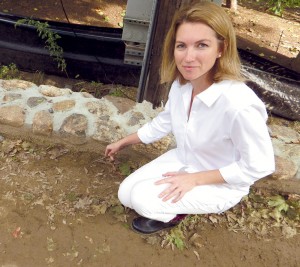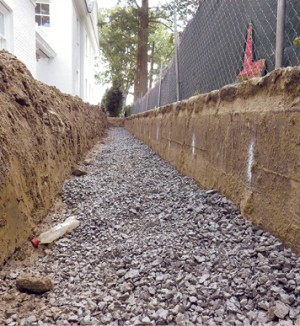Now 15 months old, Matteson Landscape Architecture in Fairfield is not yet at the capacity its principal Jessica Matteson would like to see.
She has had 12 clients in the last year, one of them commercial, and she would be comfortable with several more in the next year. She has no firm number in mind, but said, “I know I haven”™t hit max yet.”
Matteson has 20 years of landscape architecture experience in study and in practice, including a pair of degrees from Cornell University and professional stints for others in Connecticut and in Georgia.
Hers is a world of physics, horticulture, aesthetics and soil science. Her jobs do their work quietly ”” screening, filtering, slowing runoff to promote absorption ”” and as such are perhaps back-burner thoughts in the minds of many. But Matteson noted landscaping accounts for 10 to 20 percent of a project”™s total cost and is circumscribed by legislation.
Her work is designed to purpose, far more so these days than in the past.
“My focus was always environment and design,” she said. “Then I had a major shift after having two kids. Now my focus is lifestyle, about how little time we have. And when we do have time we really want to maximize it.”
The equation for private homes involves aesthetics, function and “creating a space where it”™s easier to have fun.”
For the commercial client, she asks, “What will happen there? Once I know that, I can design the space around it.”
She summed it up as “lifestyle support” that operates under the banner of being “meaningful in my life and in the lives of my clients.” For example, a recent commercial project ”” a church in New Canaan ”” incorporated eight benches for quiet contemplations among cherry trees and boxwoods and other plantings. The driveway dropoff and disabled parking areas were part of the project.
Matteson said building projects across the spectrum, from home driveway projects to office parks, are highly legislated in the name of stormwater management. Her tasks include mastering the subject, which has only grown more complex in Fairfield County with post-Superstorm Sandy flood maps.
Matteson has so far employed five different contractors for projects.
She spoke recently of the wintertime warmth that broadleaf evergreens like hollies provide versus the colder, more northerly look of spruces.
“Psychologically they just feel warmer, especially if there are a couple of layers,” she said. She came to admire broadleaf evergreens while working in Georgia, where they are used prominently. Personal journeys through famous gardens of Asia and Europe also inflect her work, she said.
On a recent morning, Matteson walked a Shore Road, Old Greenwich, property she is landscaping. Two trenches of a combined 250 feet flank the property. They are drained by perforated pipe wrapped in gravel. When the 70 mature holly trees that will soon fill the trenches have had their fill of water, the excess will flow to an 800-square-foot, 3-foot-deep rainwater containment system beneath the backyard.
The containment system also handles the rain-spout water, slowing its progress to the nearby L. I. Sound.
“With town of Greenwich stormwater regulations, you must contain and treat all your stormwater on the property,” Matteson said. She held thumb and forefinger a half-inch apart to indicate the thickness of the stormwater regulations. “The idea is to increase the infiltration of stormwater into the soil and decrease the pollution in the Sound.”
Compacted soil on site will be “scarified” ”” Matteson used the word without pause ”” and infused with 25 percent compost. Matteson scarified several inches with a stick to demonstrate. She studied soil science at Cornell, among other technical topics, earning bachelor of science and master of landscape architecture degrees. She expected good results from the decompaction process. Its density notwithstanding, the regional soil is low in phosphorous, which can stunt growth, she said.
Matteson”™s work, in the end, will appear nearly invisible, as if rows of mature hollies and spruces fell in line beside fieldstone walls. Conduits that will move water toward filtration in paths as true as the hydraulics of a big machine will soon be buried.
The Shore Road property system is but one option for managing stormwater runoff. Matteson said some choose what she called “rain gardens,” which are well-drained basins. She said the Shore Road system was more attractive, but acknowledged it also was more expensive.
She uses trees that are selected in the field and then balled in burlap; only when the root balls are measured will their holes be dug.
Matteson said others do what she does. “You can use an engineer, but I think you get more attractive solutions if you use a landscape architect,” she said.



















